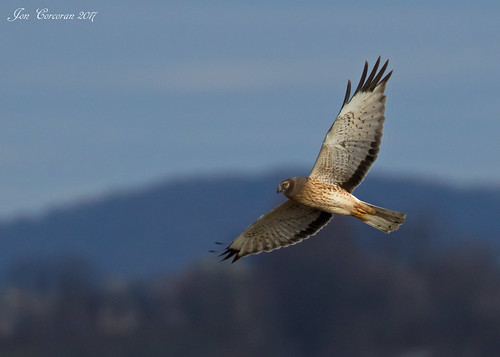Northern Harrier
(Circus hudsonius)
Conservation • Description • Habitat • Ecology • Distribution • Taxonomy
Description |
The most conspicuous identifying feature of this raptor is the apparent white rump, easily seen as it is flying away or cruising low over a field. The term “white rump” is a common but inaccurate description of the white patch at the base of the tail on this bird. The rump feathers are gray, the same color as the back and wings. It is the uppertail coverts, immediately beyond the rump, that are white. The wings are held in a strong “V” shape during flight. |
Size |
16″ to 24″ in length 42″ to 48″ wingspan |
Voice |
|
|
Similar Species |
Habitat |
Open areas |
Ecology |
Migration |
|
Nesting |
|
Food |
|
Distribution |
Occurrence |
Uncommon migrant, uncommon and local breeder |
Maps |
The Minnesota Ornithologists’ Union All Seasons Species Occurrence Map |
Taxonomy |
|
Class |
Aves (birds) |
Order |
Accipitriformes (hawks, eagles, kites, and allies) |
Family |
Accipitridae (hawks, eagles, and kites) |
Subfamily |
Accipitrinae (typical hawks and harriers) |
Genus |
Circus (harriers) |
This bird was formerly treated as a subspecies of Hen Harrier (Circus cyaneus), C. c. hudsonius being the North American form, C. c. the European form. A study comparing the Molecular phylogeny, morphology and life-history of the two forms was published in 2016. It showed “substantial mtDNA sequence divergence” and other significant differences, and concluded that “the two forms are best regarded as separate species.” The Birds of North and Middle America Checklist, the official source on the taxonomy of birds found in North and Middle America, has accepted the new classification. |
|
Subordinate Taxa |
|
|
|
Synonyms |
|
Circus cyaneus hudsonius |
|
Glossary
Coverts
Small feathers on the wings and tail of a bird that cover other feathers and help smooth airflow during flight.
Visitor Photos |
||
Share your photo of this bird. |
||
This button not working for you? |
||
Kris B |
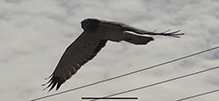 |
hunting over pipeline that crosses Division St W across the road from Bemidji high school. |
Dan W. Andree |
||
I believe it's a Northern Harrier... Seen it just recently in rural Norman Co. Mn. It was flying over a grassy area. They seem to be fairly common lately.… Anyway the Northern Harrier is neat and nice to see that seems to be a species doing okay in this region. |
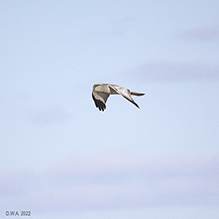 |
|
I believe this is a Juvenile Northern Harrier Hawk... It paused on a gravel road with a marsh like area on both sides. I had seen adult Northern Harriers earlier in Spring in the same area. It sat and looked around maybe looking for food like grasshoppers or something. Then eventually flew back into the large marsh like area. It had nice color and very noticeable yellow legs and beak area. |
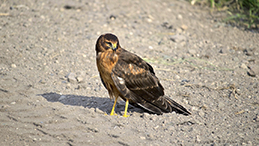 |
|
Lynn Rubey |
||
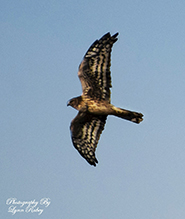 |
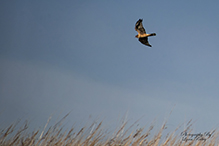 |
|
A Northern Harrier in flight over the Native Prairie Grass in The Big Stone National Wildlife Refuge. |
||
A Northern Harrier in flight in The Big Stone National Wildlfe Refuge. |
|
|
MinnesotaSeasons.com Photos |
||
|
||
|

Visitor Videos |
||
Share your video of this bird. |
||
This button not working for you? |
||
|
Other Videos |
||
Northern Harrier |
About
Published on Oct 28, 2016 Northern Harrier Hawk in classic open marshland habitat near the St. Johns River in Florida. This unique hawk has an owl-like looking face. Also called a Marsh Hawk or Hen Hawk this is a first time species on film for me - this is a migratory hawk just arriving from the north. This is what extreme zoom lenses are for. The hen harrier (Circus cyaneus) or northern harrier (in the Americas) is a bird of prey. The genus name Circus is derived from Ancient Greek kirkos, meaning "circle", referring to a bird of prey named for its circling flight. The specific cyaneus is Latin, meaning "dark-blue". It breeds throughout the northern parts of the northern hemisphere in Canada and the northernmost USA, and in northern Eurasia. This species is polytypic, with two subspecies. Marsh hawk is a historical name for the American form.[3] The term "hen harrier" refers to its former habit of preying on free-ranging fowl.[4] It migrates to more southerly areas in winter. Eurasian birds move to southern Europe and southern temperate Asia, and American breeders to the southernmost USA, Mexico, and Central America. In the mildest regions, such as France, Great Britain, and the southern US, hen harriers may be present all year, but the higher ground is largely deserted in winter. This is a typical harrier, which hunts on long wings held in a shallow V in its low flight during which the bird closely hugs the contours of the land below it. Northern or hen harriers hunt primarily small mammals, as do most harriers. Preferred prey species can include voles, cotton rats and ground squirrels. Up to 95% of the diet comprises small mammals.[13] However, birds are hunted with some regularity as well, especially by males. Preferred avian prey include passerines of open country (i.e. sparrows, larks, pipits), small shorebirds and the young of waterfowl and galliforms. Supplementing the diet occasionally are amphibians (especially frogs), reptiles and insects (especially orthopterans).[6] The species has been observed to hunt bats if these are available.[14] Larger prey, such as rabbits and adult ducks are taken sometimes and harriers have been known to subdue these by drowning them in water.[6] Harriers hunt by surprising prey while flying low to the ground in open areas, as they drift low over fields and moors.[3][7] The harriers circle an area several times listening and looking for prey.[7] Harriers use hearing regularly to find prey, as they have exceptionally good hearing for diurnal raptors, this being the function of their owl-like facial disc.[6] This harrier tends to be a very vocal bird while it glides over its hunting ground. In some parts of Europe people believed that seeing a harrier perched on a house was a sign that three people would die; on a happier note, some Native American tribes believe that seeing a hawk on your wedding day is a sign of a long, happy marriage. Unlike many raptors, hen or northern harriers have historically been favorably regarded by farmers because they eat predators of quail eggs and mice that damage crops. Harriers are sometimes called "good hawks" because they pose no threat to poultry as some hawks do. Heavy pesticide use in the 1970s and 1980s caused a decline in harrier populations. New HD videos uploaded frequently. Subscribe at: More info at: http://screech-owls.blogspot.com/ Thumbnail image: https://commons.wikimedia.org/wiki/File:Albanella-reale-femmina.jpg |
Northern Harriers Hunting (HD) |
About
Published on Feb 5, 2013 Here are several beautiful female northern harriers hunting by swooping low and slow over sunny fields and marshes while listening and watching for prey such as voles. The northern harrier is a slender, medium-sized raptor with a long, barred tail, a distinctive white rump, and an owl-like facial disk that is visible at close range. It used to be called the marsh hawk. Harriers are unusual in that there is a greater difference between male and female plumage than is typical of raptors. Females are brown above with varying degrees of brown and buff streaking below. Males are gray above with an unmarked lighter color below; they also have black wingtips. This video shows only female harriers because I couldn't find any males to film on the day of my visit. Please visit my beautiful photography website http://www.wildnwbeauty.com and my Facebook page http://www.facebook.com/WildNWBeauty for incredible high-resolution photographs of the majestic wild scenery and wildlife of the Pacific Northwest! |
Northern Harrier |
About
Published on Jun 5, 2015 Northern Harriers hunt by flying low over marshes and fields listening and looking for prey below, just as this individual is doing. Identification clues include the white patch on the rump and long wings that are often held in v-shape when they are gliding. ML Video #469369. Recorded by Eric S. Liner. For more harrier videos and sounds, explore the Macaulay Library at the Cornell Lab of Ornithology visit: http://macaulaylibrary.org For additional identification and life history information visit: https://www.allaboutbirds.org/guide/Northern_Harrier/id |
North American Wildlife --- Northern Harrier Hawk lands at Bolsa Chica Ecological Reserve |
About
Published on Apr 22, 2018 Bolsa Chica Ecological Reserve, Huntington Beach, Orange County, California, USA |
Northern Harrier # 2, juvenile..Minnesota River Valley National Wildlife Refuge 10/21 |
About
Published on Oct 22, 2012 watch in 720p Territoriality, the establishment of spatial boundaries that are aggressively defended against other members of the same species, is the rule among raptors.They do this to protect the resources upon which their lives and the lives of their mates and young depend. They do this to ensure the genetic integrity of their offspring. Different species have different needs and use different standards when establishing territories, but the size of a birds territory is generally determined by the space it feels it needs to defend itself, its mate, and its young (a nesting territory) and the amount of area it needs to hunt successfully (the hunting territory, or home range). Often the two are not the same. Harriers are rather social by the standards of most raptors, incredibly tolerant of others in their species. In winter, they often roost communally, within yards of each other, and fan out during the day to forage. Even during the breeding season, there is a great deal of overlap in hunting areas, and two or more pairs may work the same patch of marsh or field simultaneously. As such, the area around a nest that the bird will defend against intrusion by another Harrier may be quite small, several hundred square yards. The advantage inherent in defending a small territory is considerable. The less territory you have, the less time you must allocate to defending it and the more time that can be directed toward other duties--such as hunting. This consolidated defense strategy is one of the factors most often cited to explain polygamy among Harriers. Less time defending and more time hunting means greater opportunity to succeed with multiple mates and young. Territoriality benefits local populations of a species as well as individuals within a population. The establishment of territories is an effective check against overpopulation. Where adequate nest sites are not a factor and where prey is generally abundant, birds of prey distribute themselves evenly across an area...they spread out. By establishing and defending territories, they ensure that more birds will not move into an area than the area can support. The Wind Masters..The Lives of North American Birds of Prey Pete Dunne 1995 |

Visitor Sightings |
||
Report a sighting of this bird. |
||
This button not working for you? |
||
CertifiedWildlife-Habitat |
Location: Minnetonka (private property bordering Lone Lake Park & 9 Mile Creek) Observed 7' away from me on the ground, rotate head to me and back, then take flight into woods. Intermittent single sharp whistle call back over 30min. This my 3rd Northern Harrier sighting this year; usually 1/yr. Other adult has seen them, too, dating back to 5/2021. |
|
Kris B |
Location: 2 miles directly west of Bemidji, MN hunting over pipeline that crosses Division St W across the road from Bemidji high school. |
| Dan W. Andree Spring 2022 |
Location: rural Norman Co. Mn. Seen it just recently in rural Norman Co. Mn. It was flying over a grassy area. They seem to be fairly common lately.… Anyway the Northern Harrier is neat and nice to see that seems to be a species doing okay in this region. |
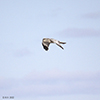 |
| Lynn Rubey 10/29/2018 |
Location: Big Stone National Wildlife Refuge A Northern Harrier in flight in The Big Stone National Wildlfe Refuge. |
 |
| Dan W. Andree 8/2/2018 |
Location: Norman Co. MN It paused on a gravel road with a marsh like area on both sides. I had seen adult Northern Harriers earlier in Spring in the same area. It sat and looked around maybe looking for food like grasshoppers or something. Then eventually flew back into the large marsh like area. It had nice color and very noticeable yellow legs and beak area. |
 |
MinnesotaSeasons.com Sightings |
||

Created: 8/5/2018 Last Updated: © MinnesotaSeasons.com. All rights reserved. |
